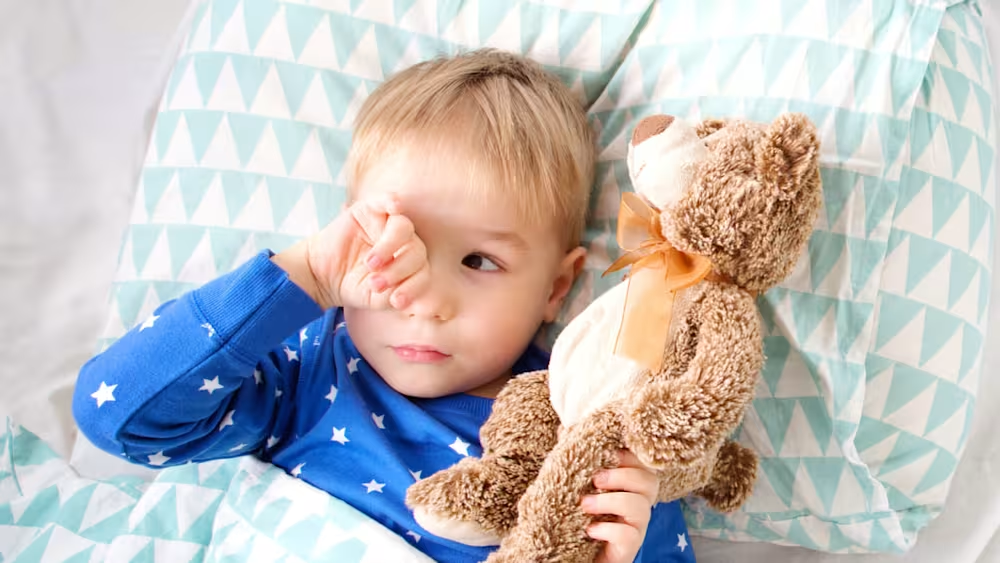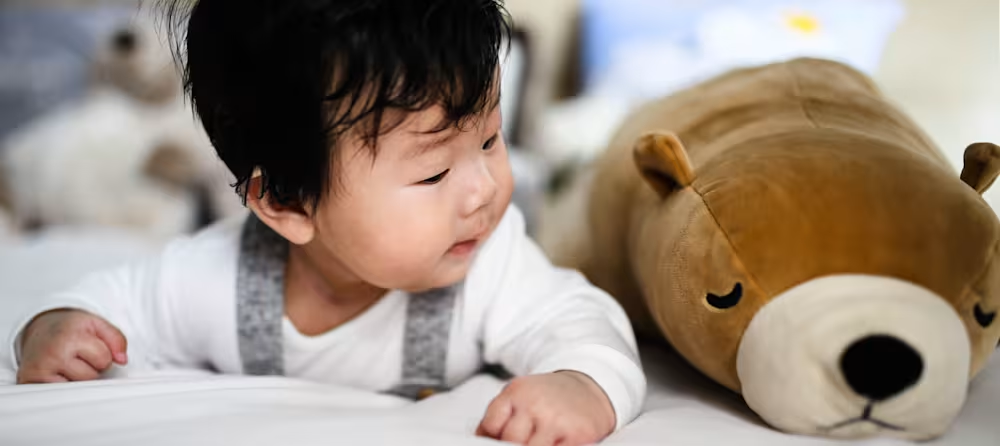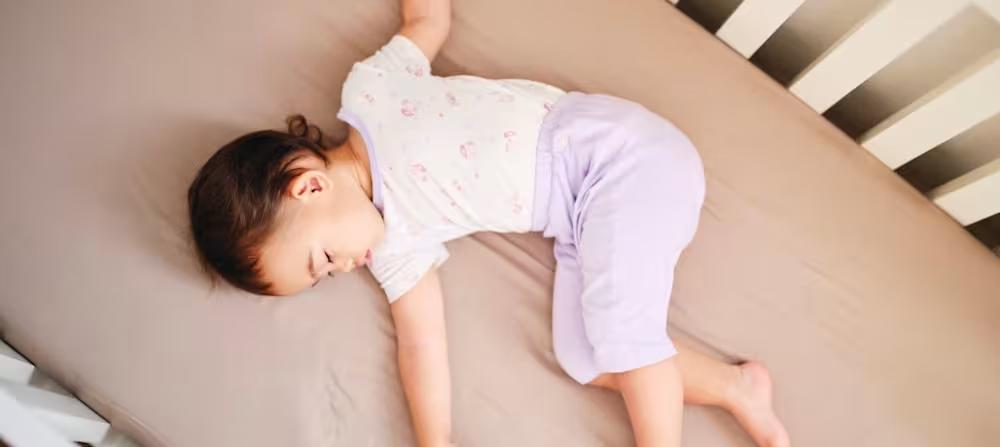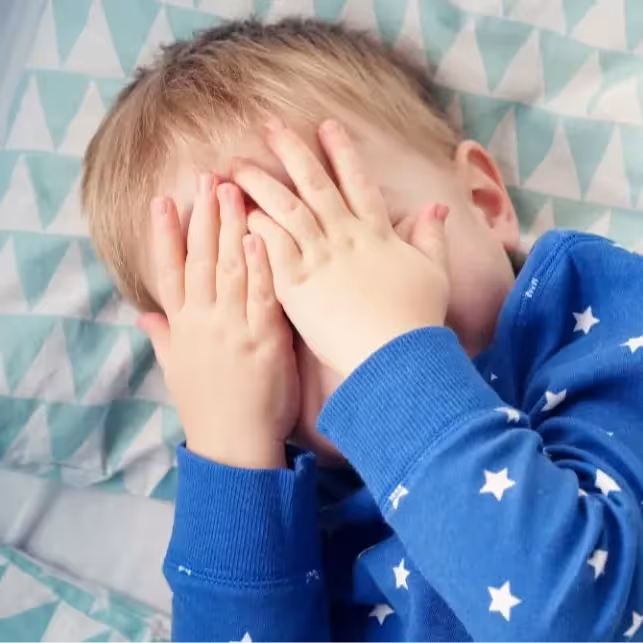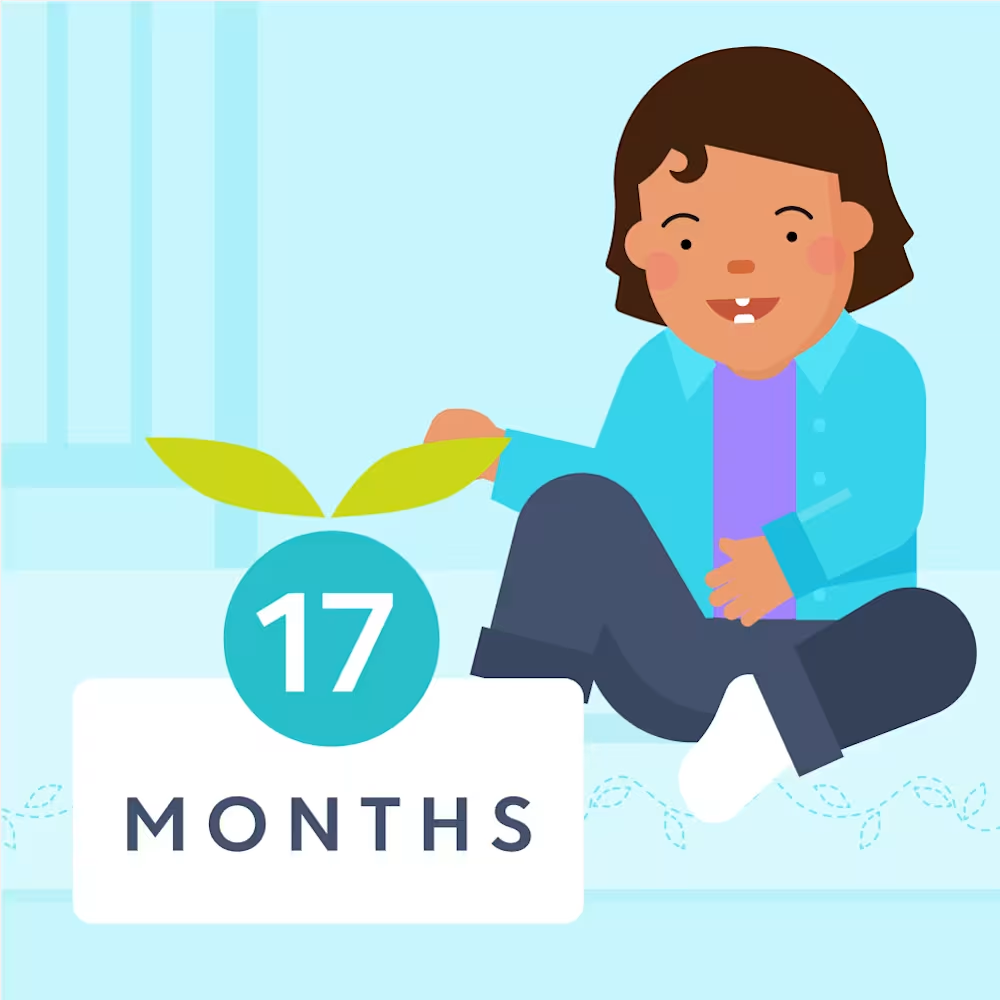18 month sleep regression: What causes it and what to do?
Updated Dec 16, 2025

At 18 months old, your “baby” likely seems more and more like a toddler. While that includes like talking and walking without support, there are often less exciting aspects too — like navigating meltdowns and periods of challenging sleep. It can be a tricky phase for children and parents! In this article, we’ll fill you in on the so-called “18 month sleep regression” and give you tips for getting sleep back on track. Toddlerhood brings big changes and plenty of big feelings, but it doesn’t mean sleep has to go out the window (for them or you!).
Table of Contents
Is there an 18 month sleep regression?
Baby sleep regressions don’t magically stop once your child turns 1. Sleep challenges can pop up at any age — though there are certain windows where disruptions are more common. That’s why you might hear terms like the “18-month sleep regression” thrown around. But it’s not as if your toddler will suddenly start resisting naps or waking more overnight the moment they hit 18 months.
Some toddlers experience bumpy sleep at 14, 15, or 16 months… others closer to 17, 18, or even 19 months — and some may skip this phase entirely. Every child is different and what’s “normal” can vary widely. Plus, the degree to which this period of development impacts a child’s sleep will depend on their routines and the parent’s response. Let’s take a look at some of the developmental milestones and factors that can influence sleep patterns at this age.
How do I know if my baby is in the midst of a sleep regression?
Generally, when experts talk about sleep regressions, we’re talking about a situation where the quality and ease of a child’s sleep suddenly declines. Parents may notice a variety of changes in their toddler’s sleep habits.
Signs of a sleep regression include:
Refusal to sleep at bedtime
Increased nighttime wakings
Early waking
Nap regression
Shorter naps (often one sleep cycle)
What’s special about the 18 month sleep regression?
At 18 months, various factors may lead to a sleep regression.
Seeking independence
Separation anxiety
Teething
Nap transition
We'll explain more in-depth below:
Seeking independence
In the 14 - 19 month age group, children are typically settling into toddlerhood. Along with talking, walking, and many other exciting milestones, kiddos often begin testing boundaries and seeking independence too. Instead of laying down and falling asleep at bedtime like they may have been doing, they’re suddenly exploring ideas like, “Hmmm...what would happen if I just kept playing instead? Or maybe I’ll throw all of my pacifiers on the floor! Hey, I wonder if I can climb out of this crib...”
While frustrating, these behaviors are developmentally appropriate and signal that your child is gaining confidence and curiosity. This is a normal part of growing up, even if it makes bedtime a little harder for a bit.
Separation anxiety
Heightened — when being away from a caregiver can cause a child to become very upset — is often a contributor to poor sleep at this age. It’s a normal and healthy part of development [], though some children may experience it more intensely than others. If your child is especially clingy right now, it may be harder for them to fall asleep (and stay asleep) if they’re upset about being apart from you. This can affect both naps and overnight sleep.
Teething
A child’s first pesky molars often start to break through the gums around this age. As a result, children who are teething often want more comfort [] from their parents, particularly at.
Nap transition
To complicate matters, most children are ready to drop their afternoon nap and in the middle of the day between 14 - 18 months. As children adjust to longer wake windows, they’re often extra tired by bedtime. Overtiredness can make it harder for little ones to fall asleep and stay asleep, which may create a tricky cycle of poor sleep.
My 18 month old won’t nap. Does 18 month regression affect naps?
Sleep regressions don’t only disrupt nights — they can throw daytime sleep off, too. Around 18 months, most toddlers have moved to a 1-nap schedule and nap for 2 - 3 hours during the day. However, if they’ve recently switched to one daily nap, it may take some time for the nap to lengthen. This is normal, but it can impact nighttime sleep if your kiddo takes a short nap — or skips a nap — and becomes overtired before bedtime. When kids get overtired, they may struggle to fall asleep and stay asleep, which can lead to a cycle of poor sleep.
If you’re feeling stuck and want more help with your toddler’s sleep, we can help! With , you can submit for a personalized, step-by-step Sleep Plan for your child.
How long is the 18 month sleep regression?
Unfortunately, there’s no set timeline for when sleep disruptions might start and end. That said, it’s common for toddlers between 14 and 19 months to go through periods of unsettled sleep — often lumped under the term “18 month sleep regression.” Some toddlers navigate this stage without any issues, while others may struggle with falling asleep, staying asleep, waking very early, or suddenly deciding naps are highly overrated.
How long sleep regressions last can vary, depending on what’s causing the sleep hiccups and the steps taken to support better rest. For example, if your kiddo had been sleeping great and then gets a painful new chomper, they will likely go back to sleeping well once it breaks through the gum and the discomfort subsides. On the other hand, if a toddler is experiencing separation anxiety, they may get stuck in a new habit (like a parent patting their back until they fall asleep) that impacts sleep for much longer.
What can parents do to minimize the effects of a toddler sleep regression?
All of these rapid developmental changes can be a recipe for one cranky toddler. Toddlers lack the communication skills necessary to calmly explain why they don’t want you to leave at bedtime or why they’re waking you up repeatedly each night. Cue the tears — and sometimes not only from your toddler. Sleep challenges are hard on parents too! Luckily, there are ways you can help your child during a period of rocky sleep.
Tip | Notes |
Offer an age-appropriate bedtime | Adjust bedtime based on nap schedules. When your toddler drops to one nap, earlier bedtimes may be needed until they can comfortably stay awake longer. |
Prioritize naps | Ensure your toddler gets at least one daily nap, using active morning play, outdoor time, and limited screen exposure to ensure they're tired at naptime. |
Set consistent pre-sleep routines | Follow the same steps in the same order before each nap and bedtime to cue sleep, promote security, and reduce bedtime resistance. |
Offer extra comfort as needed | Lengthen the routine with cuddles or reassurance when your toddler is teething or going through separation anxiety, but be mindful that consistent help can shift sleep expectations. |
Consider sleep training | Teach independent sleep skills to reduce night wakings. Some approaches are gentler and take more time, while others can produce faster results and may include more tears in the short term (like "cry it out"). |
Find more details below:
Tip #1: Offer an age-appropriate bedtime
When younger toddlers still take two daytime naps, bedtime can creep later, which can be great — you don’t have to rush to get dinner ready early and there’s more playtime before sleep.
However, once a child drops to one nap, bedtime often needs to move much earlier again, at least at first.
Many children in this age group can only comfortably stay awake for about 5 hours at a time.
That means if their nap ends at 1:00 PM, they may be ready for a set bedtime as early as 6:00 PM until they adjust to staying awake longer.
Tip #2: Prioritize naps
Most toddlers are ready for a 1-nap schedule at this age and will continue to need a nap until at leat 3 years of age. Yet nap resistance is common at this age.
To help encourage an age-appropriate sleep schedule, try stimulating those developing minds and bodies in the morning. Roll a ball. Play simple games like puzzles and blocks. Limit screen time. Get out in the sunshine when you can. These simple measures may help your child feel tired and sleep easier at naptime.
Tip #3: Set consistent pre-sleep routines
Children of all ages thrive on routines. If you haven’t already, now is a great time to implement consistent pre-sleep rituals. We recommend doing the same set of steps in the same order before each nap and at night. And it doesn’t have to be complicated! A bedtime routine may include:
Put on PJs
Brush teeth
Read a couple of books
Snuggles and kiss goodnight
Setting boundaries and staying consistent with your bedtime routine can help children wind down in the evening and understand that sleep comes next []. This leads to a feeling of security and, hopefully, fewer tears.
At this age, many toddlers can also benefit from a longer bedtime routine in dim light (~45 minutes) in order to cue the body that it’s time to sleep. Bedtime routines have been shown to not only improve sleep but also contribute to improved developmental outcomes [].
However, the more we “give in” and deviate from the routine, the more likely we are to see sleep disruptions []. When we intermittently reinforce boundary-testing behavior (by giving in sometimes, but not others), this often encourages the behavior and sends a confusing message to the child.
Tip #4: Offer extra comfort as needed
While consistently enforcing healthy sleep routines is vital to maintaining your child’s sleep progress, there are times when kids need some extra TLC.
If your 18 month old isn’t sleeping through the night and is suddenly struggling to fall asleep independently, it makes sense to offer them more comfort, especially if you suspect they’re in pain from teething or going through a strong bout of separation anxiety. Consider lengthening your pre-sleep routine to include extra cuddle time to promote that comfort and security they’re seeking. Speak to your pediatrician about teething pain medication [], if necessary.
Parents may also decide to help their child fall asleep temporarily. While it’s understandable to want to help your toddler get the sleep they need, keep in mind the extra support can change their expectations surrounding sleep.
If you regularly help them fall asleep (like stay in the room when you used to leave) they’ll often expect that every night — and possibly throughout the night too.
Tip #5: Consider sleep training
Studies show that children have fewer sleep problems when they learn to fall asleep [] without parental help at bedtime. If your child needs your assistance to fall asleep, consider. Keep in mind the "cry it out" method isn't the only option.
In general, sleep training is a process to help your child strengthen their independent sleeping skills. “Cry it out" (CIO or the extinction method) is one of many approaches.
There are a variety of ways to sleep train and the “right” one for your child depends on your family's needs and preferences. Some approaches are gentler and take more time, while others can produce faster results and may include more tears in the short term (like CIO).
What if I want more personalized support during a sleep regression?
Feeling stuck? When your family is ready, we can help you get back on track. Huckleberry Premium was created to make sleep consultations for children more affordable for families. We take into consideration each family's individual lifestyle as well as their sleep goals when working to create a successful sleep plan. If you are interested in more personalized analysis and guidance for your child, sign up for.
How much sleep does an 18 month old need?
We recommend aiming for around 13 - 14 hours of total sleep per day for kiddos . This typically looks like at least 11 hours overnight and 2 - 3 hours of daytime shuteye. Most children make the between 14 - 18 months, so your little one may already be fully transitioned to 1 daily nap. If they’re still taking 2 naps or flip-flopping throughout the week, that’s OK too. However, if you find they’re regularly resisting daytime sleep, it may be time to drop that afternoon nap.
Keep in mind these are general guidelines, not strict rules. It’s normal for children to have higher or lower sleep needs. Pay attention to your little one’s overall mood and energy levels when determining if they’re getting the rest they need.
How can I tell if it's separation anxiety or 18 month sleep problems?
Separation anxiety often lessens as toddlers still need reassurance, but are more aware of their blossoming independence. Your child knows you’ll return, but strong emotions can sometimes make separations feel overwhelming for a while.
Bedtime separations can be especially challenging and may show up as bedtime resistance or more frequent night waking. Offer reassurance, stick to predictable routines, and remember this is a common and temporary developmental phase.
How can I tell if it's teething or 18 month sleep problems?
At 18 months, many toddlers are cutting molars, which can be uncomfortable. Teething can lead to soreness, irritability, and disrupted sleep, making it hard to separate teething from general sleep challenges. Providing comfort before bed and maintaining consistent routines can help your toddler rest through this phase.
Can you sleep train during a sleep regression?
Even during periods of rocky sleep, is an option at 18 months. Teaching your toddler independent sleep skills and self-soothing can lead to better rest and fewer night wakings — for both of you. The key is finding an approach that aligns with your child’s temperament and your parenting style. Some gradual techniques offer more support but may take a few weeks (or longer) to notice results. Others, like the Ferber method, tend to work faster but can involve more crying upfront.
Can I let my 18 month old cry it out during a sleep regression?
“Cry it out” (CIO) or extinction method can be used during an 18 month “sleep regression.” This approach may be helpful if the check-ins associated with other methods (like Ferber method) tend to make your child more upset. If you choose CIO, be sure your toddler’s basic needs are met first: they should be fed, dry, and in a safe sleep environment. Consider using a video baby monitor for peace of mind while giving your child the space to settle to sleep. If you have questions or concerns about sleep training, check in with your family’s pediatrician before getting started.
What are self-care tips for tired parents?
Take 5 for yourself in the morning: Whether it’s drinking your coffee, getting some fresh air, or a quick meditation session, try to sneak in a few minutes for yourself before the chaos of the day sets in. This intentional time can set the tone for the day.
Offer limited choices: Toddlers are all about independence and giving them simple choices can go a long way in reducing power struggles. Try offering two options when it makes sense — like, “Do you want the red shirt or the blue one?” It won’t prevent every meltdown, but giving your toddler a sense of control can help them feel more confident and make your day a little smoother too.
Talk it out: Parenting is hard — parenting toddlers can feel like an Olympic sport. Commiserating can go a long way in reassuring you this phase is normal (you’re not the only one who’s had to deal with full-blown grocery store tantrums). Vent, laugh, and lean on your support system.
Should I let my toddler sleep in my bed during a regression?
The American Academy of Pediatrics (AAP) advises against bedsharing during a baby’s first year to help reduce the risk of SIDS []. After 12 months, the official guidance becomes less specific. While the AAP still doesn’t formally endorse bringing your child into bed, the risk of SIDS decreases significantly a year.
If you bring your child into bed at 18 months, still prioritize safety and be aware of potential risks like falls, suffocation, and entrapment. Safe sleep best practices include:
Use a firm mattress
Keep pillows and heavy blankets away from your child
Avoid sharing the bed with anyone using substances that affect alertness
When to talk to a doctor
Sleep may still be a bit of a roller coaster — even during the toddler years. Most of the time, these phases are completely normal and nothing to worry about (though they’re frustrating and exhausting). That said, there may be times when your child’s sleep patterns seem unusual or raise concerns. If something doesn’t feel right, it’s always okay to check in with your child’s pediatrician. You know your child best and it’s usually preferable to err on the side of caution.
Here are some instances where you might consider checking in with your child’s doctor:
Persistent fussiness: Signs of pain, extra hard to soothe
Feeding or weight gain concerns: Consistently skipping meals, not gaining weight as expected (though growth slows down in your baby’s second year)
Unusual symptoms: Vomiting, a lingering cough, fever, rash etc.
Unusual sleepiness: Overly drowsy, hard to wake
Other red flags: If something feels off, contact your healthcare provider.
Takeaway
What is the 18 month sleep regression?: The "18 month sleep regression" refers to a period between 14 and 19 months of age when parents tend to see recurrent sleep issues arise. However, there’s not a magical date on the calendar that predicts sleep regressions. They can happen at any time.
Common signs of a sleep regression: Taking longer to fall asleep at bedtime, frequent nighttime wakings, early morning rise time, nap protesting, and shorter naps.
Why is sleep bumpy at this age?: Around this age, toddlers are typically going through big changes like seeking independence, experiencing separation anxiety, teething (thanks, pesky molars!), and a transition to a 1-nap schedule. These factors can contribute to a sudden onset of sleep issues.
How to improve sleep at 18 months: Offer an age-appropriate bedtime, prioritize naps, be consistent with setting limits and consistently enforcing your child's bedtime routines.
18 month sleep regression FAQ
Share article:
Note: The content on this site is for informational purposes only and should not replace medical advice from your doctor, pediatrician, or medical professional. If you have questions or concerns, you should contact a medical professional.
9 Sources
Table of Contents
Share article:
